
Serious earnings, serious challenges
Ten percent of first-cycle programme graduates and 17% of second- and long-cycle graduates live in one of the five Polish largest cities. Despite seemingly favourable circumstances in the local labour markets, the recent graduates residing in those cities continue to face challenges. Although their relative earnings are high, they remain lower than the average local earnings of all other graduates. It also takes longer for young alumni to find regular jobs. The risk of unemployment among recent graduates in large cities is low—albeit higher than the wider unemployment rates in their regions. Alumni who live in Łódź enjoy the highest relative incomes.
Population
Almost 39,000 of all the graduates who earned their degrees in 2020 lived in one of the five largest cities in Poland: Warsaw, Kraków, Łódź, Wrocław, and Poznań. They included those with the title of bachelor (first-cycle programmes) and master (second-cycle and long-cycle programmes): 16,458 and 22,336 individuals, respectively. This means that 10% of recent bachelor’s graduates and 17% of master’s graduates lived in the largest cities. Of those, 60% resided in Warsaw and Kraków, with as few as 4,000 residing in Łódź.
Graduates in the largest cities in Poland
First-cycle programmes
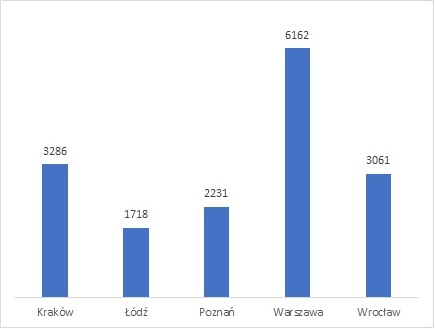 Second- and long-cycle programmes
Second- and long-cycle programmes
 Source: ELA report (7th edition)
Source: ELA report (7th edition)
ELA data is used to analyse how the graduates in large cities fared in the labour market in terms of their earnings (expressed in PLN and in the form of a relative rate), time spent searching for a regular job (expressed in months), and the level of unemployment (expressed in percentage values and as a relative rate).
The relative rates used in the analysis compare the circumstances of graduates to the situations in their regions or cities. Relative rates enable comparisons that consider the specifics of local labour markets.
Earnings
In each of the largest cities, the average earnings of the graduates exceeded PLN 4,000 gross, which was higher than the average for all graduates. In real figures, the alumni who lived in Warsaw earned the most in absolute terms, while those residing in Poznań earned the least. If we compare the graduates' earnings to the average earnings in specific cities, we can observe that the 2020 graduates fall below the average calculated for all graduates. This indicates that competition among job seekers who have recently entered the labour market is strong.
Graduates of bachelor’s degrees (first-cycle programmes)
Earnings in PLN
 relative earnings rates
relative earnings rates
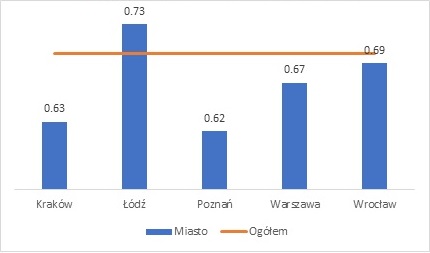 Source: ELA report (7th edition)
Source: ELA report (7th edition)
Graduates of master’s programmes earn slightly more than those of bachelor’s programmes. Salaries in Warsaw exceeded PLN 5,000 gross and were marginally lower in other cities. The nominal earnings of the graduates in large cities exceeded the average for all graduates.
The highest relative earnings can be found among the graduates in Łódź, who achieved a relative earnings rate comparable to the average for all graduates. The earnings of recent graduates in other cities compared to the average are relatively lower. The lowest relative earnings were those of graduates living in Kraków (69% of the average).
Graduates of master’s degrees (second- and long-cycle programmes)
Earnings in PLN
 relative earnings rates
relative earnings rates
 Source: ELA report (7th edition)
Source: ELA report (7th edition)
Time spent searching for a regular job
The graduates monitored (except those in Łódź) spent more time searching for regular jobs than average. Graduates in Łódź could quickly find employment, while those in Kraków needed considerably more time. Although, in relative terms, finding a job was not excessively time-consuming for graduates in Warsaw, they still needed more time for it than average.
Average time (in months) graduates spent searching for a regular job
Graduates of bachelor’s degrees
(first-cycle programmes)
 Graduates of master’s degrees
Graduates of master’s degrees
(second- and long-cycle programmes)
 Source: ELA report (7th edition)
Source: ELA report (7th edition)
Unemployment
The risk of unemployment among the graduates of bachelor’s programmes in Łódź and Kraków was higher than in other cities. However, the risk of unemployment among the students monitored was higher than the risk to the general population (excluding graduates who live in Łódź).
Graduates of bachelor’s degrees (first-cycle programmes)
Risk of unemployment
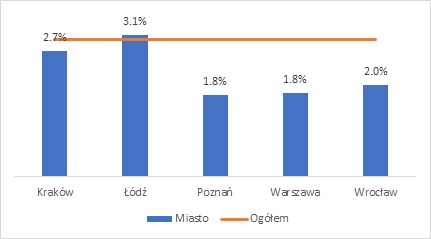 relative unemployment rates
relative unemployment rates
 Source: ELA report (7th edition)
Source: ELA report (7th edition)
In the case of master’s programmes, the highest risk of unemployment could be observed in Kraków, and the lowest in Poznań and Warsaw. With consideration for the rates of unemployment in those cities, residents of Kraków and Wrocław fared relatively worse, while graduates in Łódź had the least to worry about.
Graduates of master’s degrees (second- and long-cycle programmes)
Risk of unemployment
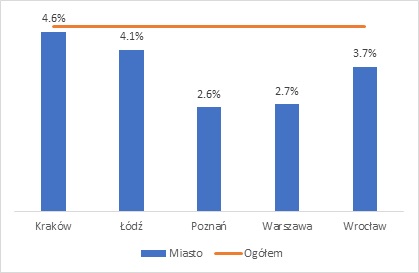 relative unemployment rates
relative unemployment rates
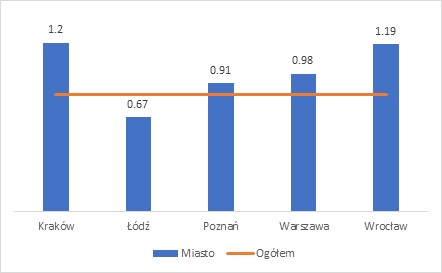 Source: ELA report (7th edition)
Source: ELA report (7th edition)